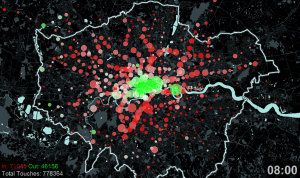Over the last couple of months we have been working on getting our
GeoSocial Gauge system up and running. The idea behind the website is to bring together social media and geographical analysis to monitor and explore people’s views, reactions, and interactions through space and time. It takes advantage of the emergence of social media to observe the human landscape as the living, breathing organism that it is: we can witness the explosion-like dissemination of information within a society, or the clusters of individuals who share common opinions or attitudes, and map the locations of these clusters. This is an unprecedented development that broadens drastically our understanding of the way that people act, react to events, and interact with each other and with their environment. We refer to this novel approach to study the integration of geography and society as GeoSocial Analysis.
 |
| Screen shot of GeoSocial Gauge of the Sequester. Showing the location of tweets, the most frequent words and whether or not the messages are positive (green) or negative (red). |
 |
| Screen shot of GeoSocial Gauge of The Walking Dead. |
Some of our initial work on this type of analyis can be found at:
- Stefanidis, T., Crooks, A.T. and Radzikowski, J. (2013), Harvesting Ambient Geospatial Information from Social Media Feeds, GeoJournal, 78, (2): 319-338.
- Crooks, A.T., Croitoru, A., Stefanidis, A. and Radzikowski, J. (2013), #Earthquake: Twitter as a Distributed Sensor System, Transactions in GIS, 17(1): 124-147.
Continue reading »














